Jane Seymour’s story is a captivating one, woven into the very fabric of English history. Though her life was tragically short, she left an indelible mark on the Tudor dynasty and the course of England’s future. Born around 1509, Jane entered the royal court as a lady-in-waiting to Queen Anne Boleyn, a position that would ultimately lead her to the throne.
Her marriage to Henry Viii in 1536, following the dramatic downfall of Anne Boleyn, marked a turning point for both Jane and England. She brought a sense of calm and normalcy to the turbulent court, earning the respect and affection of Many Within It. Unlike some of her predecessors, Jane was known for her quiet grace and gentle demeanor, qualities that appealed to the weary king after years of political turmoil and personal upheaval.
While Jane Seymour childhood remains shrouded in relative obscurity, her impact on history is undeniable. She fulfilled Henry’s long-held desire for a male heir with the birth of Edward Vi in 1537. Sadly, she died just nine days later From Puerperal Fever, leaving behind a legacy that continues to fascinate and inspire centuries later.
Early Life & Family Background
While much of Jane Seymour’s early life remains a mystery, historians believe she was born around 1509 into a relatively modest but respectable family. Her father, Sir John Seymour, was a prominent landowner and member of the gentry in Wiltshire, England. Her mother, Margery Wentworth, came from a noble family with connections to the royal court. This familial background likely provided Jane with a comfortable upbringing and exposed her to the world of nobility and politics from a young age.
Jane’s childhood was probably filled with the typical pursuits of a young noblewoman: Music Lessons, embroidery, dancing, and social gatherings. She would have received a basic education in reading, writing, and arithmetic, though formal schooling for girls at that time was often limited. Her upbringing instilled in her values of piety, decorum, and loyalty, traits that would later serve her well in the demanding environment of the Tudor court.
 J.D. Salinger Early Life: A Look at the Authors Beginnings
J.D. Salinger Early Life: A Look at the Authors BeginningsIt’s fascinating to consider how these formative years shaped Jane Seymour into the woman who would eventually capture the heart of King Henry Viii. Although details about her Jane Seymour childhood are scarce, we can glean glimpses of a young woman raised with refinement and surrounded by the expectations and opportunities of her social standing.
Marriage to Henry VIII
Jane Seymour’s life took a dramatic turn in 1536 when she became the third wife of King Henry Viii. The tumultuous events leading up to her marriage were driven by Henry’s desire for a male heir and his growing discontent with his previous wife, Anne Boleyn. After years of political maneuvering and Religious Upheaval, Anne was accused of treason and executed, paving the way for Jane to enter the royal spotlight.
Henry Viii had been captivated by Jane’s gentle demeanor and quiet grace, qualities that stood in stark contrast to the more assertive personalities of His Previous Wives. Her reputation for piety and loyalty made her a seemingly ideal candidate for the throne. The marriage took place just eleven days after Anne Boleyn’s execution, showcasing the swiftness and ruthlessness with which Henry Viii pursued his ambitions.
Jane was crowned Queen on May 1st, 1536, marking the beginning of a brief but significant chapter in English history. Her reign was marked by a sense of stability and tranquility, offering a welcome respite from the drama that had characterized the previous years. However, their happiness was short-lived, as Jane’s story tragically unfolded just months later with the birth of their son, Edward Vi.
Queen and Mother: Edward Vi’s Birth
Jane Seymour’s time as queen was brief but momentous. She brought a sense of peace and order to the court after the tumultuous reign of her predecessor, Anne Boleyn. Her quiet grace and gentle demeanor were a welcome contrast to the Previous Queen’s Fiery Personality. The king, weary from years of political intrigue and personal upheaval, found solace in Jane’s Calm Presence.
Their happiness reached its peak on October 12, 1537, with the birth of Edward Vi, Henry Viii’s long-Awaited Male Heir. The news spread like wildfire throughout England, heralding a new era for the Tudor dynasty. Edward’s arrival filled the kingdom with hope and promise, finally fulfilling Henry’s desperate desire for a son who would secure the throne and continue His Lineage.
Sadly, Jane Seymour’s joy was cut short. She succumbed to puerperal fever just nine days after giving birth to Edward Vi. Her death plunged the court into mourning and left a void that could never be filled. Despite her tragically short reign, Jane Seymour is remembered for bringing peace and stability to the kingdom and for fulfilling Henry’s greatest ambition by giving him a Son Who Would Become King.
Legacy and Burial at Windsor Castle
Though Jane Seymour’s life was tragically cut short, her legacy endures as the only one of Henry Viii’s six wives to be buried with him at St. George’s Chapel in Windsor Castle. This distinction speaks volumes about the king’s deep affection for her and his recognition of her pivotal role in securing the Tudor dynasty’s future.
Her tomb, a magnificent marble monument adorned with Intricate Carvings, serves as a lasting testament to her enduring impact on history. It stands as a symbol of both her tragic demise and the profound love she shared with Henry Viii. Visitors to Windsor Castle today can still marvel at this poignant reminder of Jane Seymour’s brief but significant reign.
Her memory continues to captivate historians and enthusiasts alike, who delve into the details of her life and legacy. Though much remains shrouded in mystery, Jane Seymour’s story serves as a powerful reminder of the complexities of love, loss, and power within the context of Tudor England.
The Enduring Impact of Jane Seymour
Jane Seymour’s impact on history extends far beyond Her Brief Time As Queen. She is remembered for bringing a sense of stability and peace to the turbulent court of Henry Viii, offering a stark contrast to his Previous Tumultuous Relationships. Her gentle nature and quiet grace provided a much-needed respite amidst the political upheaval and religious turmoil that defined the Tudor era.
Most importantly, she secured Henry Viii’s legacy by giving birth to Edward Vi, who would become king and ensure the continuation of the Tudor dynasty. This pivotal moment in history forever linked Jane Seymour’s name with the fate of England. Her story serves as a reminder that even brief lives can have profound and lasting consequences, shaping the course of nations and leaving an indelible mark on history.










